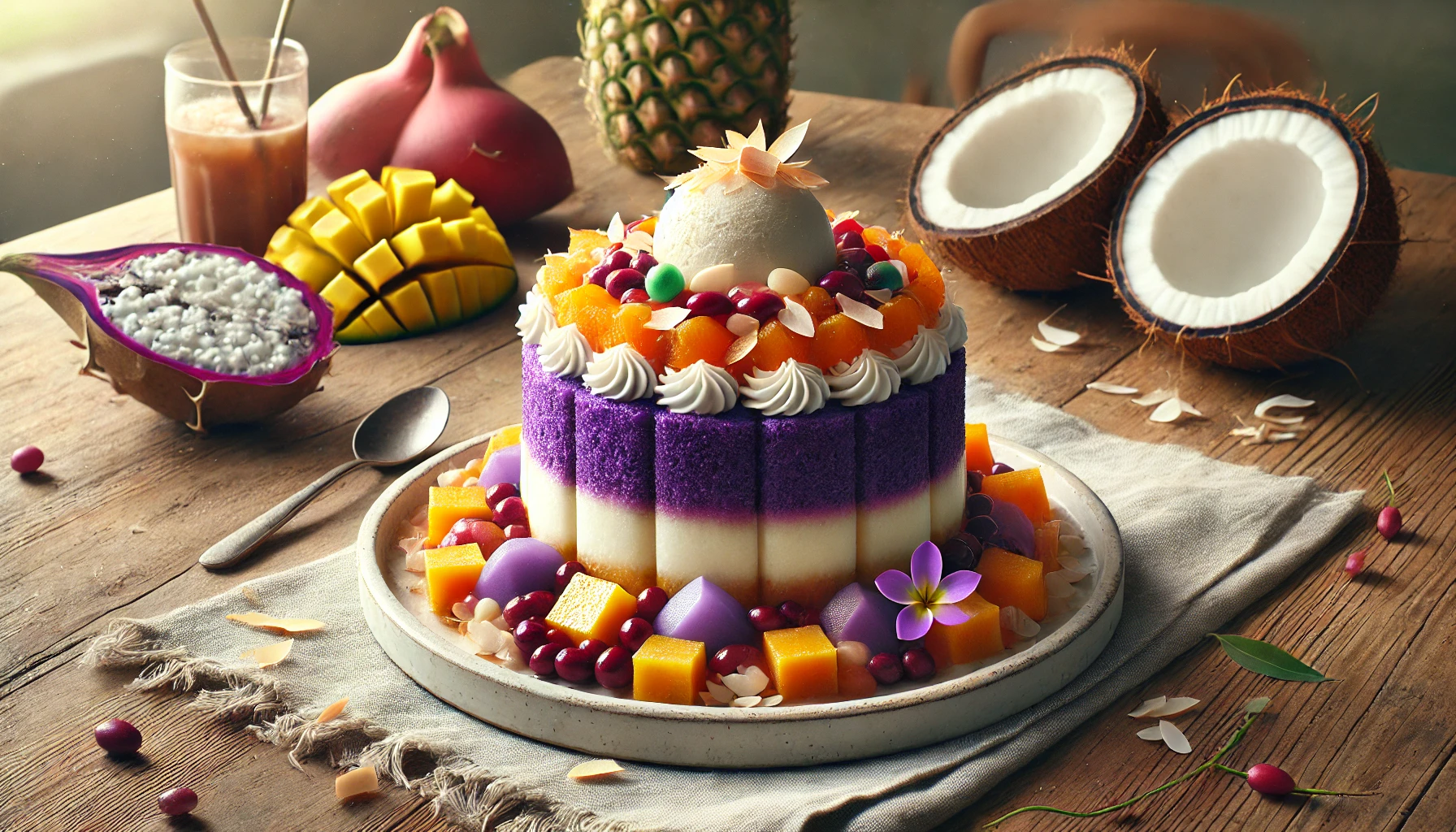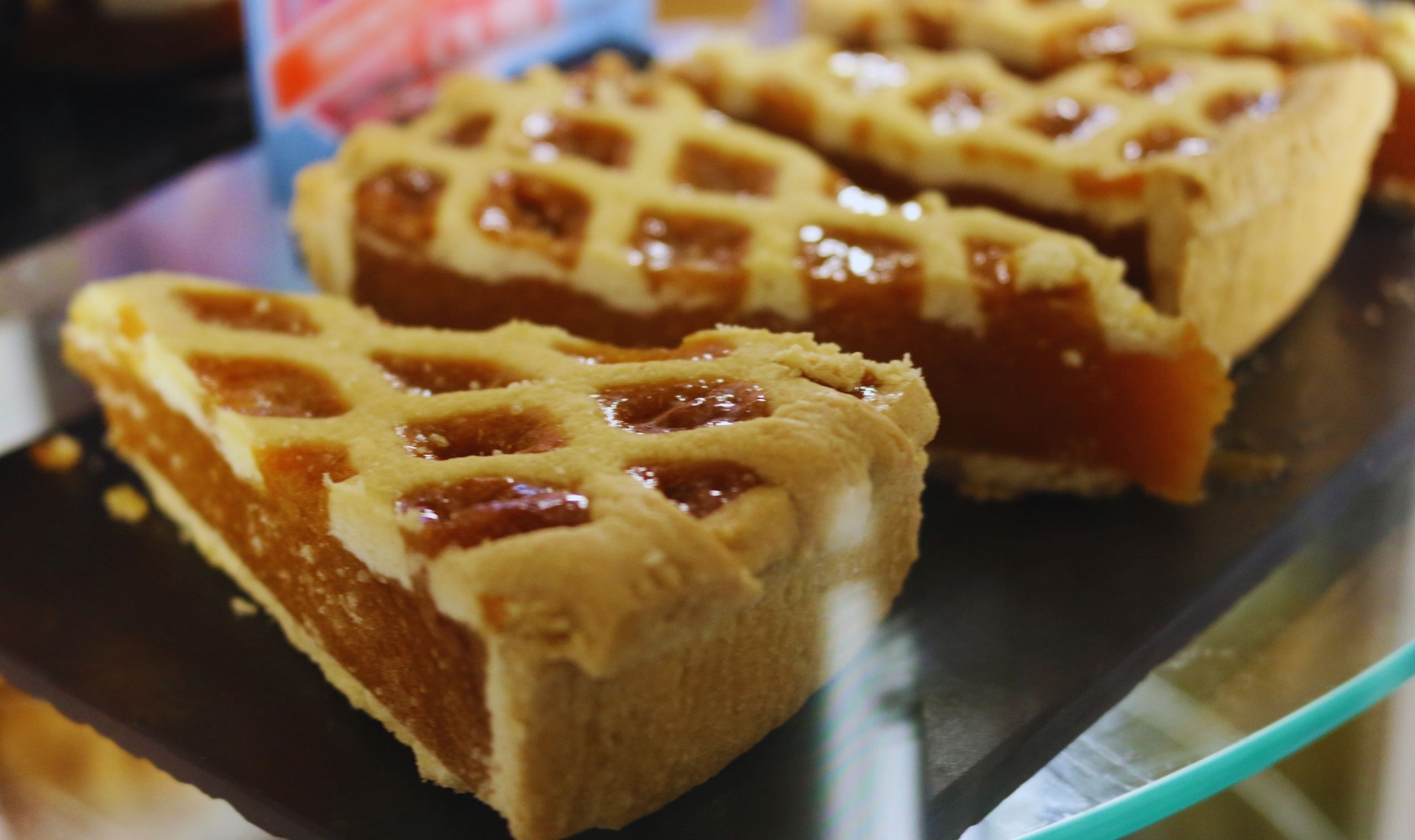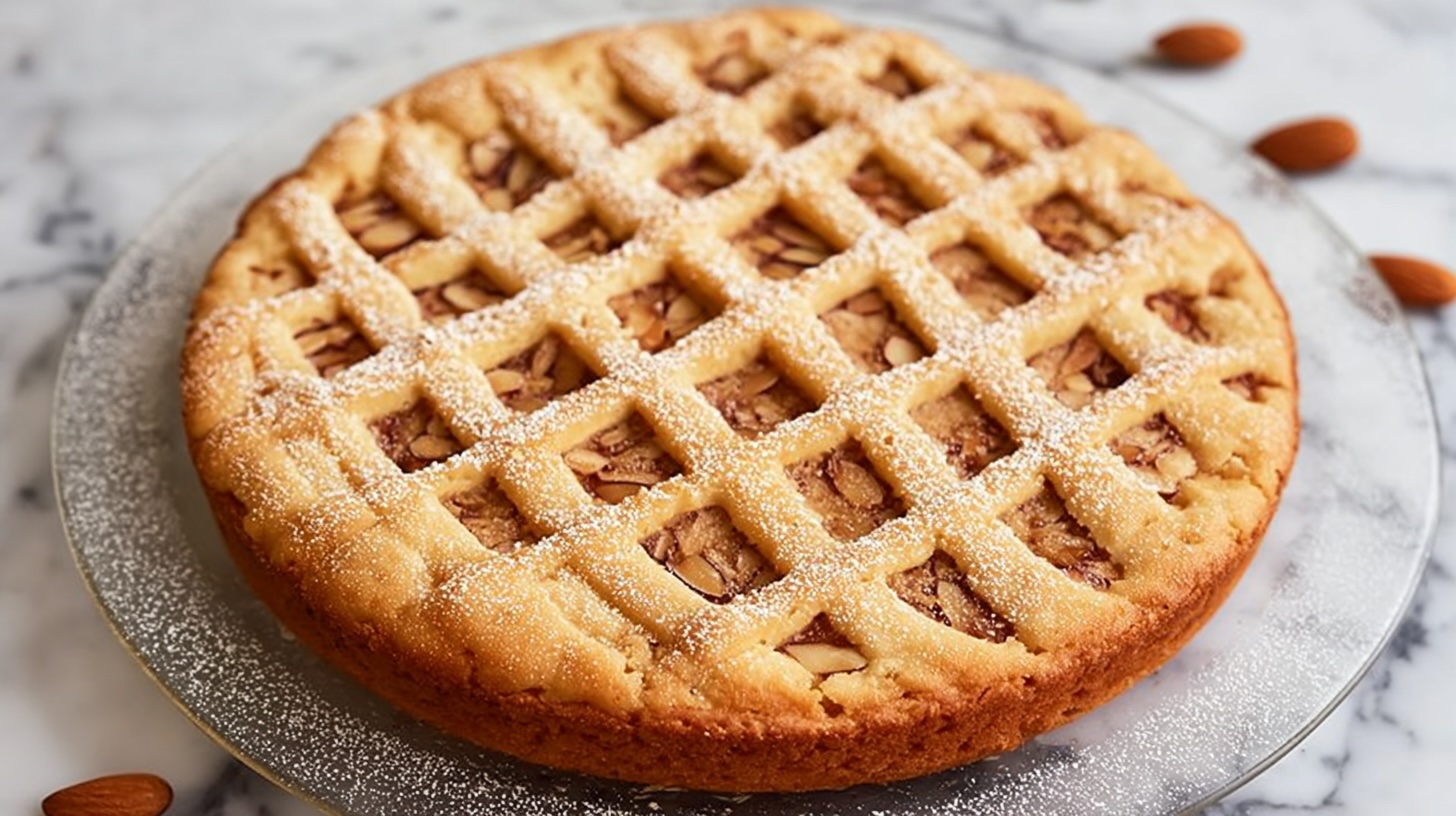Halo-Halo Cake: A Sweet Journey Through Filipino Flavours
Halo-Halo Cake: A Dessert Revolution
Halo-Halo Cake is here to bring chaos into your dessert game, and trust me, it’s the good kind of chaos. If you’ve ever experienced the Filipino dessert halo-halo (“mix-mix”), then you know it’s a glorious mishmash of textures and flavours. Now imagine all that colourful brilliance wrapped up in a flaky, buttery cake crust. Yes, it’s as mad and magical as it sounds. It’s the kind of dessert that makes you wonder why you didn’t think of it yourself while simultaneously thanking the genius who did. There’s something almost rebellious about taking a classic, chilled dessert and turning it into a warm, comforting slice of heaven—a rebellion your taste buds will thank you for.
But what makes this dessert truly unique is its ability to bridge cultures and flavours, combining the comforting familiarity of cake with the tropical exuberance of halo-halo. It’s a dessert that invites you to explore the depth of Filipino cuisine while savoring something innovative. Whether served at a family gathering or showcased in a chic bakery, Halo-Halo Cake is a conversation starter, a symbol of culinary creativity, and a testament to the power of fusion foods to surprise and delight.
The Curious Origins of Halo-Halo
Halo-halo is quintessentially Filipino, but its roots trace back to Japan. Yes, Japan. The Japanese dessert kakigōri, a shaved ice treat topped with sweet beans, found its way to the Philippines during the early 20th century. Over time, the Filipinos did what they do best: they gave it a tropical twist. They added local fruits, jellies, leche flan, ube, and anything else that could make your sweet tooth sing. And thus, halo-halo was born—a dessert that celebrates abundance, creativity, and a touch of whimsy.
As halo-halo grew in popularity, it became a staple in Filipino households and restaurants, especially during the sweltering summer months. Its evolution into a cake is a testament to the Filipino love for innovation and indulgence. After all, why stop at shaved ice when you can reinvent the whole dessert experience? By reimagining halo-halo as a baked good, bakers have created a masterpiece that merges the old and the new. The warm, buttery crust contrasts beautifully with the traditionally chilled ingredients, creating an entirely new sensory experience.
The cultural journey of halo-halo also tells a story of adaptation and resilience. What began as a Japanese dessert evolved into a Filipino icon, and now, through its transformation into a cake, it has captured the imagination of food lovers worldwide. This continual reinvention shows that halo-halo isn’t just a dessert; it’s a living tradition.
Turning a Dessert into a Cake
Enterprising bakers have a knack for taking something already amazing and making it somehow even better. Halo-Halo Cake is a modern invention that’s gaining popularity among Filipino fusion foods. It takes all the elements of halo-halo—sweetened bananas, macapuno, nata de coco, jackfruit, and more—and nestles them into a cake crust. Because why have shaved ice when you can have buttery pastry? The crust provides a delightful contrast to the soft, luscious filling, creating a textural symphony that’s hard to resist.
This cake is more than a dessert; it’s a celebration. Every bite is a journey through flavours and textures, a playful nod to tradition wrapped in modern ingenuity. It’s also a fantastic way to introduce halo-halo to those who might find the original dessert’s complexity a bit intimidating. With a cake, you get all the joy in a more structured form—and who doesn’t love cake? The interplay of creamy and crunchy textures, along with the sweetness of tropical fruits, makes it a dessert like no other.
In addition, Halo-Halo Cake offers endless possibilities for creativity. Bakers can customize the ingredients to suit local tastes or seasonal availability. It’s a canvas for innovation, where every layer tells a story. Imagine incorporating unique flavors like calamansi for a tangy twist or infusing the crust with hints of pandan to deepen its tropical character. This adaptability ensures that every Halo-Halo Cake is a personal expression of its creator’s culinary vision.
Regional Spins on Halo-Halo Cake
Just like halo-halo itself, this cake is open to interpretation. In Luzon, you might find versions loaded with ube halaya and generous chunks of leche flan. Down in Mindanao, they might throw in durian, because they’re not afraid of bold flavours. Some bakers experiment with mangosteen or pomelo for a tangy twist, while others add crispy elements like barquillos or caramelised coconut shreds for extra crunch.
The possibilities are as varied as the Philippines’ 7,641 islands, and every family seems to have their own twist. Some cakes lean heavily into the fruity side, while others emphasise the creamy, custardy components. Whichever way you slice it, Halo-Halo Cake is a versatile canvas for culinary creativity. Regional takes might even include rare, seasonal fruits or locally sourced ingredients, giving each cake a unique identity that reflects its maker’s roots.
For example, a Visayan version might highlight mangoes and coconut, while a Bicolano spin could incorporate pili nuts and spicy undertones. Every adaptation reflects the richness of the region’s culinary traditions, making Halo-Halo Cake a delicious way to explore the diversity of Filipino flavors.
Drinks That Make Halo-Halo Cake Even Better
Halo-Halo Cake is sweet, rich, and complex, so you’ll need a drink to balance things out. Filipino sago’t gulaman, with its refreshing mix of tapioca pearls and jelly in sweet syrup, is a perfect match. Feeling fancy? Pair it with a hot cup of barako coffee for a contrast of bold bitterness. For something lighter, a simple iced tea with calamansi will do the trick.
If you’re in the mood for something a little more indulgent, try a creamy avocado milkshake or a tall glass of buko pandan. The mellow, nutty flavours of these drinks beautifully complement the rich layers of the cake, enhancing its tropical allure. You could even push the boundaries with a chilled glass of taho (sweet silken tofu dessert) to mirror the cake’s creamy elements while adding a unique twist to the pairing.
For adventurous palates, experiment with pairing Halo-Halo Cake with fruity cocktails. A refreshing mango mojito or a coconut rum punch could elevate the experience, adding a celebratory vibe to the occasion. Non-alcoholic enthusiasts might enjoy pairing it with a ginger iced tea or a citrus-infused sparkling water for a zesty contrast.
Foods That Love Halo-Halo Cake
Filipino food is all about harmony, so why stop at dessert? Serve your cake alongside classic mains like chicken inasal or pork adobo to end the meal with a bang. If you’re hosting a party, a spread of pancit and lumpia will keep things festive. And don’t forget a side of salted eggs—because a touch of savoury always makes the sweet shine brighter.
For the adventurous, pair the cake with street food classics like grilled isaw (chicken intestines) or fish balls. It might sound unconventional, but the smoky, savoury flavours create a delightful contrast with the cake’s sweetness. Think of it as a new take on sweet and savoury harmony. Some daring hosts have even paired this cake with tangy green mango and bagoong, creating an explosion of flavours that’s truly unforgettable.
Additionally, Halo-Halo Cake can play a starring role in themed dinner menus. Imagine a tropical feast that begins with kinilaw (Filipino ceviche) and ends with a slice of Halo-Halo Cake. This kind of curated experience showcases the depth and breadth of Filipino cuisine, leaving your guests both impressed and satisfied.
Why You Should Make It
Why? Because it’s delicious. Because it’s a showstopper at parties. Because it’s like eating nostalgia wrapped in crust. But most of all, because life is short, and you deserve dessert that makes you feel like a tropical queen or king.
It’s also surprisingly therapeutic to make. The act of assembling the ingredients, layering the flavours, and baking the cake is as much an experience as eating it. Plus, the look of awe and delight on people’s faces when they try it for the first time? Priceless. Sharing a slice of Halo-Halo Cake feels like offering a piece of your own cultural pride, wrapped in buttery, golden perfection.
Moreover, making Halo-Halo Cake is a delightful way to connect with your roots or share your heritage with others. It’s an invitation to celebrate culture, one bite at a time. As you mix the ingredients and craft the layers, you’re not just baking a cake; you’re creating a memory, a story, and a delicious piece of edible art.
The Ultimate Halo-Halo Cake Recipe
Cake crust: You’ll need a double crust, one for the bottom and one for the top. Use your favourite recipe or cheat with store-bought. We’re here for the filling.
The filling: Combine 1 cup of sweetened macapuno, ½ cup of nata de coco, 1 cup of sweetened jackfruit, ½ cup of cooked saba bananas (or plantains), and ½ cup of ube halaya (purple yam jam). Toss with ½ cup of sweetened condensed milk and a teaspoon of vanilla extract. Sprinkle in some crushed pinipig (toasted rice flakes) if you’re feeling traditional…
Assembly: Roll out your bottom crust and fit it into a cake dish. Pour in the filling and spread it evenly. Top with the second crust, crimp the edges, and cut a few vents to let the steam escape. Brush the top with an egg wash for that golden finish.
Baking: Preheat your oven to 190°C (375°F). Bake the cake for 45-50 minutes, or until the crust is golden brown and the filling is bubbling. Let it cool completely before serving—if you can wait that long.
Serving: Serve slices chilled or at room temperature. Top with a dollop of whipped cream, a drizzle of condensed milk, or even a scoop of ice cream if you’re feeling indulgent. For the ultimate halo-halo experience, garnish with a sprinkle of pinipig and a slice of leche flan. You can even go bold with a drizzle of coconut caramel or a sprinkle of crushed cashews for an added layer of decadence.
Now go forth and bake your chaos cake. The only rule is to have fun and mix, mix, mix it up!



